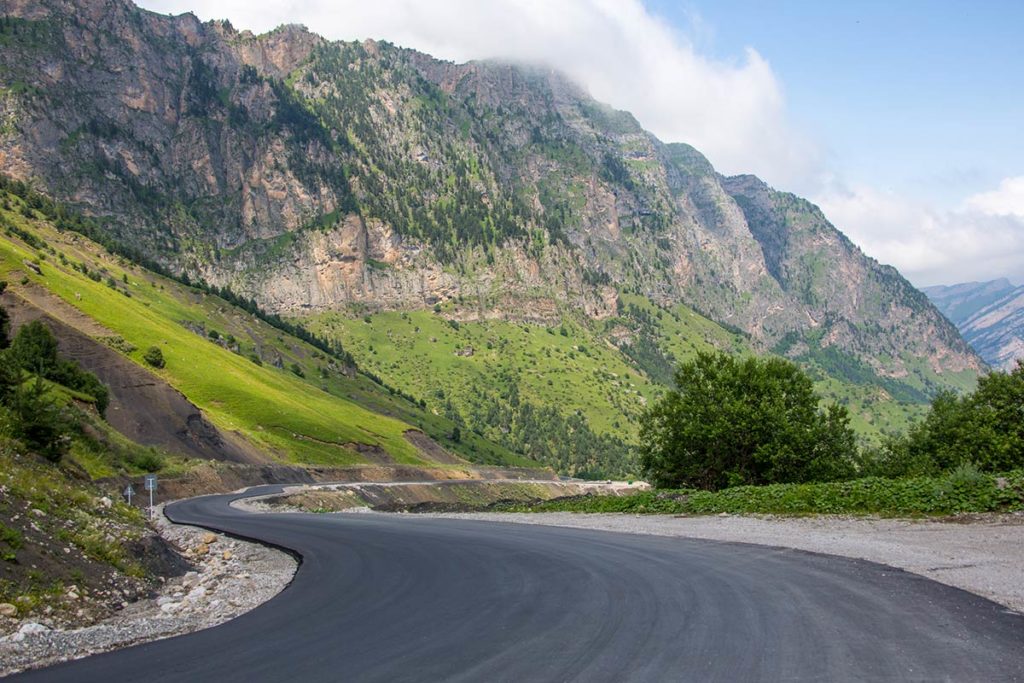
BELOW ME THE SILVER-CAPPED CAUCASUS LIES
Below me the silver-capped Caucasus lies…
A stream at my feet rushes, foaming and roaring.
I watch a lone eagle, o’er the peaks calmly soaring
Drift near as he motionless circles the skies.
Here rivers are born that tear mountain asunder
And landslides begin with a crash as of thunder.
Here float solemn storm-clouds; and through them cascade
Swift torrents of water; they plunge o’er the edges
Of great, naked cliffs and spill down to the ledges
That patches of moss and dry brushwood invade.
Beneath spread green groves, lush with herbs and sweet-scented
Where birds dwell in peace and where deer browse, content.
Lower still in the hills, nestle men; flocks of sheep
The pasturelands roam; to the gay, flowery meadow
Where courses Arafva, her banks clothed in shadow,
A shepherd descends. In a narrow and deep
Ravine a poor horseman lurks, tense and unsleeping,
And wild, laugh-crazed Terek goes tumbling and leaping.
He lashes about like a beast in a cage
With food out of reach, full of hunger and craving,
And licks at the boulders, and, howling and raving,
Strikes out at the shore in a frenzy and rage.
Alas! He is thwarted: the mountains surround him;
Mute, threatening giants, they press darkly round him.
Alexander Pushkin
The Caucasus
These words of Alexander Pushkin still characterise North Ossetia – Alania. Among the constellations of the North Caucasian republics, Ossetia shines unusually brightly and this is the only region where the language, beliefs and customs of the mysterious Alanian tribes are almost completely preserved.
The unity of man and nature in culture
These are nomads of Scythian-Sarmatian origin, the language of modern Ossetians speaks of their belonging to Indo-European peoples, and their beliefs are distinguished by a syncretic nature. These are tribal cults and elements of world religions that have preserved a rich heritage of paganism. The unity of man and nature, the deification of certain places: natural mountains of individual stones, trees, groves, springs, artificially created for sacrifice and prayers, which Ossetians perform to this day, as well as many festive funeral rites. They strictly adhere to many traditions to this day: weddings are celebrated according to ancient customs, rituals at the birth of children, for example, the naming squad is a separate festive ritual, then the ritual of introduction into the family and protection from the influence of “evil forces”.
Quite recently, in the middle of the 20th century, a custom that was adopted by the Scythian-Sarmatian tribes – the dedication of a horse to the deceased and the installation of cirts (gravestones), which migrated from the Scythian culture to the Alanian, and then to the Ossetian, disappeared quite recently. There are such monuments only in North Ossetia and Alania. They are not necessarily buried; they often stand as memorial signs near the roads.
History and architecture
Ossetia is a small Caucasian republic which is endowed with unique traditions and historical monuments. Fortresses, towers, ancient settlements and crypts have been preserved in the gorges. The largest in the Caucasus Dargav crypt necropolis is located on its territory, and the vast Koban burial ground was discovered, which gave its name to the most ancient Koban culture.
In the 19th century, the capital of Ossetia, Vladikavkaz, became the centre of the Terek region, which included Dagestan, Chechnya, Ingushetia, Kabardino-Balkaria and the Stavropol Territory. Therefore, the city had a huge number of educational institutions, developed industry and trade. The first theatre in the North Caucasus, terrains for cycling, the first cinema in Russia, and a railway. These were all built in Vladikavkaz. There was also established a Belgian concession, which not only built factories for the processing of non-ferrous metals in cities and mountains, but also launched a tram in Vladikavkaz. Therefore, the architecture is beautiful, buildings in the Art Nouveau and eclectic style prevail, many old buildings have been perfectly preserved, although more than 20 churches belonging to different denominations were destroyed during the Soviet period.
Breathtaking landscapes
North Ossetia has an unusually beautiful nature and many magnificent locations. But glaciers are something special, bewitching and alluring with their scale, grandeur, beauty and inaccessibility. Most of them can be reached only on foot or by cable car, and each of them is unique and recognisable. The area of glaciation is more than two hundred thousand square meters, but the glaciers have been retreating and decreasing lately.
It is worth coming to Ossetia for the sake of the mountains alone. At any time of the day and time of the year, you can endlessly watch the snowy peaks emerge from behind the clouds. Stunningly beautiful views from the passes, numerous gorges – all this together restores mental balance and enriches the inner world.
Cuisine
And of course, a little about Caucasian cuisine. Famous Ossetian pies this year took second place in the Tastes of Russia competition in the Cultural Heritage nomination. Why? It is customary to put three pies on the festive table in Ossetia, and before eating them, it is customary to pray for prosperity, abundance and other good things. Only two pies are put on a memorial table. Authentic Ossetian pies can be tasted only in this republic, because Ossetian cheese is produced only there, and pies with other cheeses, accordingly, have a completely different taste. Do not believe it if someone told you that it can be replaced with feta cheese, mozzarella, feta or suluguni!
They make pies with various fillings: with cabbage, wild garlic, pumpkin, cherries, potatoes, beans… But pies with cheese, beet tops and minced meat are considered classics. Real Ossetian pies are made from yeast dough and generously greased with butter. If they are heated in a skillet with oil, they only taste better the next day.
Ossetia has very strong traditions of hospitality, they love feasts and observe a lot of different rituals, which makes Ossetia a truly original, unique republic.
You are always welcome!
by Tatiana Lari
